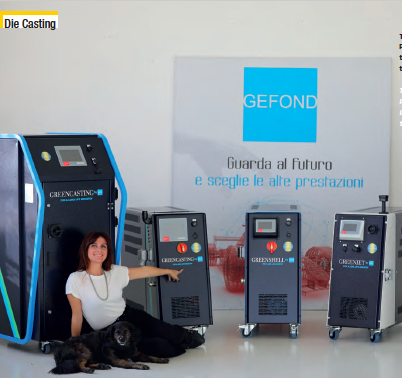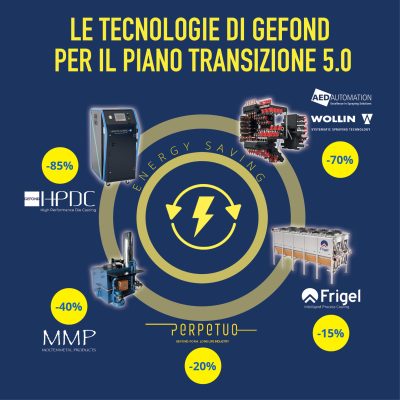Blog

Let's talk about process optimization Hpdc by Gefond: for more control over the casting process
By Franco Pollio D'Avino and Daniele Sagone Article published by A&L number 6 2023
How to make the process more controlled? With the HPDC by Gefond range of temperature control units, we are able to achieve a better result through process control.
We present three cases of three different types: lubricate MicroSpray Wollin with Greencasting pressurized water multi-circuit controllers; gravity produced component testing with Greenshell in New Olef; jetcooling technology with Greenjet 50.
The control unit range and new products will be presented at Euroguss 2024 from Jan. 16-18 at the Gefond booth 330/Hall 9.
On Jan. 15 at the plenary session on die casting, organized by BDGuss Federal Association of the German Foundry Industry at the Nuremberg Exhibition Center, Daniele Sagone, sales technician at HPDC by Gefond, will present "The New Frontier of Thermoregulation in Foundry: Energy Savings, Process Optimization, and Predictive Maintenance."
Greencasting: lubricates MicroSpray Wollin and thermoregulation.
Given Gefond's experience in optimizing die casting processes on both the thermoregulation and lubrication sides, and having experienced these processes in several foundries, we arrived at some strategic considerations to improve processes and be more competitive in the market.
In all use cases, we have seen that the combination of Wollin lubricator (particularly with Ecospray technology) - Greencasting Hpdc temperature control unit succeeds in best optimizing the process.
The use of release agents for MicroSpray technology, such as oils and concentrates, changes the foundryman's approach to the lubrication process. Whereas previously the focus was on cooling the mold with lubrication, now the focus is on using it solely for the main purpose for which it is done: to allow the casting to come off the mold.
To get the maximum results for using this technology, it is necessary:
- Microdosing the product: nozzle accuracy and repeatability are critical.
- heat subtraction by thermoregulation, as this is no longer subtracted by evaporation of the water-based release agent.
Wollin offers two different technologies for the application of MicroSpray lubricant.
The first type of Eco+Spray DD / DDV nozzles (volumetric nozzle) is used in static applications (needs a jig head in most cases). It requires a preliminary study of the mold thermal since the amount of heat removed from the release agent is zero.
The second type of EcoSpray FSD nozzles (fine spray nozzle) is used in dynamic applications (does not require a jig head), with the ability to move the lubrication head within the mold area. It, too, requires prior evaluation of the mold thermal but less stringent, as water-based products can be used that allow a small cooling effect.
Thermoregulation Hpdc by Gefond combined with MicroSpray lubricant.
Gefond offers the ideal solution to go with this type of lubrication: the Greencasting Hpdc by Gefond pressurized water multi-circuit controllers.
With the ability to have differentiated cooling for up to 30 circuits and a large heat exchange capacity, the Greencasting control unit allows for the management and disposal of the amounts of heat involved in the case of MicroSpray lubrication.
In this way we arrive at a correct and homogeneous mold temperature before lubrication.
Our Greencasting power packs, in order to increase heat exchange compared to conventional power packs, use a pulse working method. In this way, the flow from laminar becomes turbulent, thus increasing the heat exchange coefficient by 30%.
The simulation performed showed these results.
Greenshell: testing of component produced in gravity at customer New Olef, gravity and low-pressure foundry of MCA industries group
The customer had a concentrated shrinkage porosity issue in a specific area (a dowel). The mold's temperature control circuits were manifesting a sharp drop in flow rate a few days after cleaning in addition to pockets of vapor obstructing normal flow.
Thanks to our Greenshell control unit with 4-bar working pressure and closed and filtered circuit between mold and machine , the rejection rate after RX went from 25 percent down and stabilized below 5 percent.
Greenjet 50: new technology for jetcooling
Based on the new requirements of foundries, we developed a new Jetcooling unit for microchannel cooling.
Starting from customers' needs, we modified some operating parameters and added some functions: the working pressure is now adjustable from 7 to 19 bar, we introduced direct reading of the flow rate of each individual circuit (on time), circuit leakage testing at each cycle, and Microsiemens reading of circulating water with alarm for exceeding threshold. It also does not require sophisticated filtration. Greenjet 50 is prepared for predictive maintenance with Perpetual software.
You can also control the process by taking care of the machinery
Revamping used lubricators
With its long experience in the diecasting machinery industry, Gefond expertly carries out the overhaul of used lubricating equipment.
Aging of lubrication systems, even with good scheduled maintenance, is an inevitable process that leads to slow performance deterioration.
To obviate this risk, Gefond has well-established partnerships with the represented houses (Wollin and AED formerly Acheson) to offer a quick and comprehensive repair and overhaul service that guarantees: high expertise, troubleshooting, inspection and fault diagnosis, reconditioning, and replacement with original spare parts.
In addition to value for money, reconditioned machinery saves natural resources and preserves the environment. In fact, a reconditioned machine requires less use of new raw materials and saves the energy needed to produce a new one.
The overhaul process also takes into account so-called enhanced maintenance, which brings machinery up to the technological state of the art, incorporating, where possible, technical solutions found on newer machines. Machinery reconditioned by Gefond guarantees reliability, quality and longevity comparable to that of new machinery, with the goal of maintaining efficiency at the maximum point (BEP = Best Efficiency Point).
Read the full article A&L6-2023

